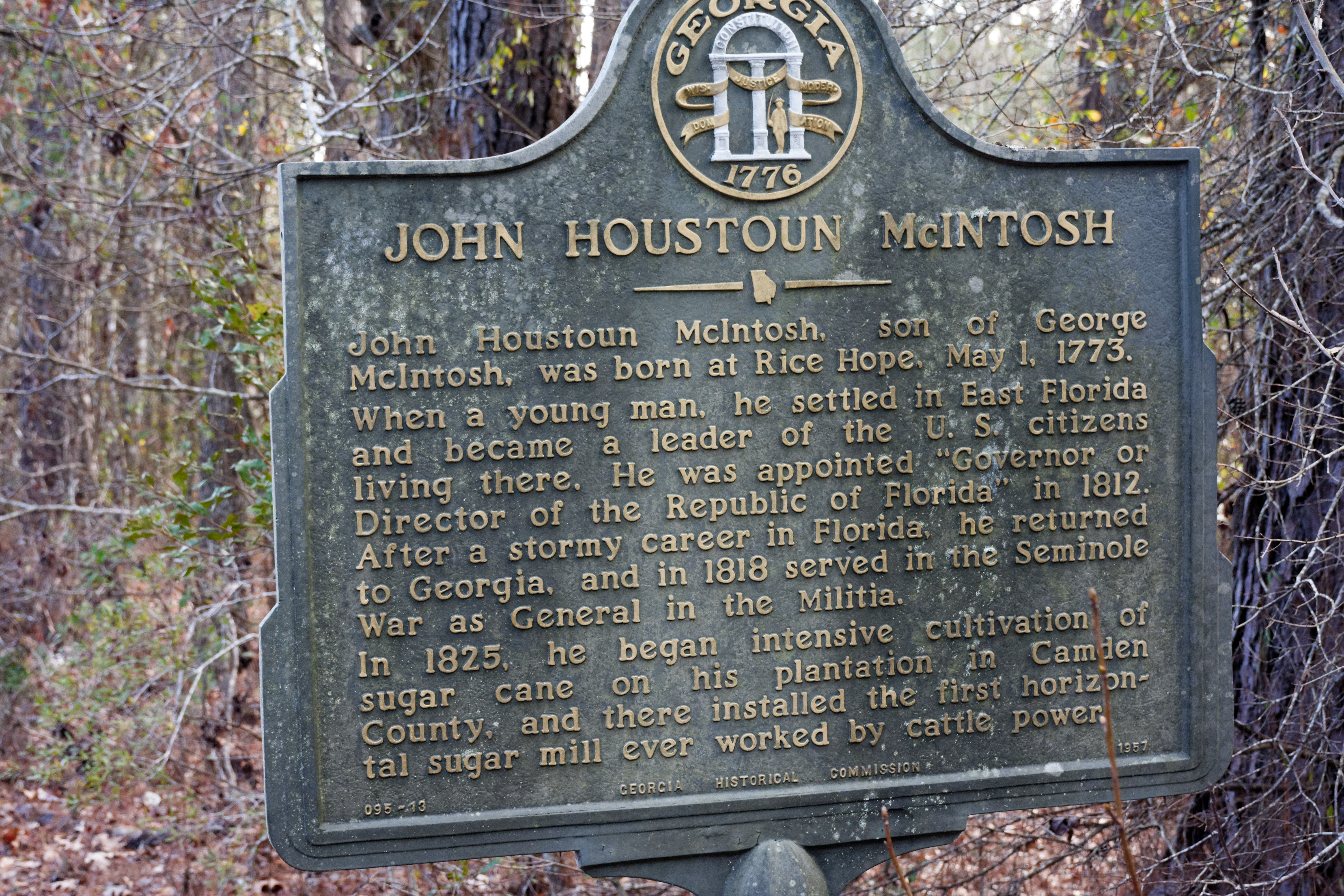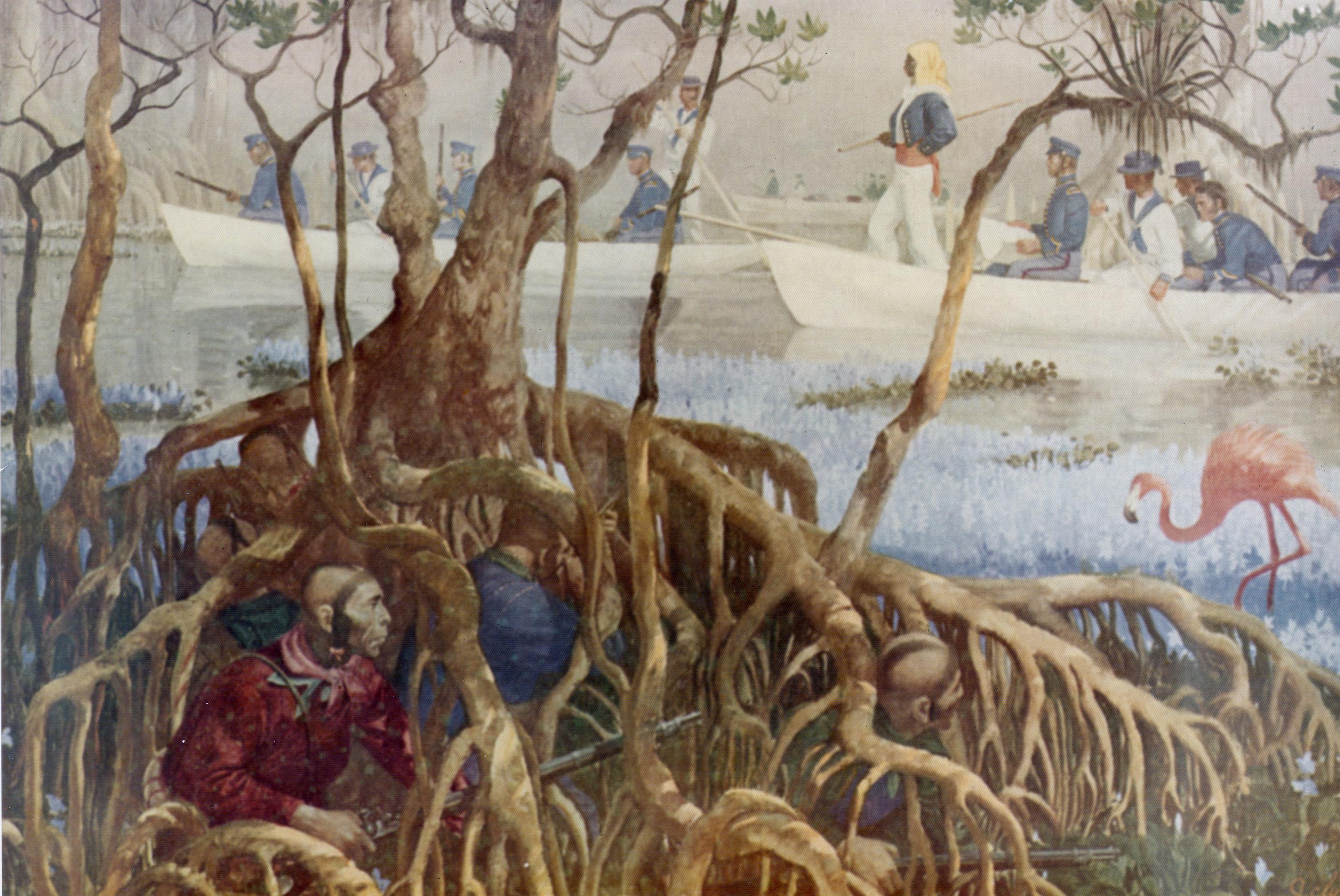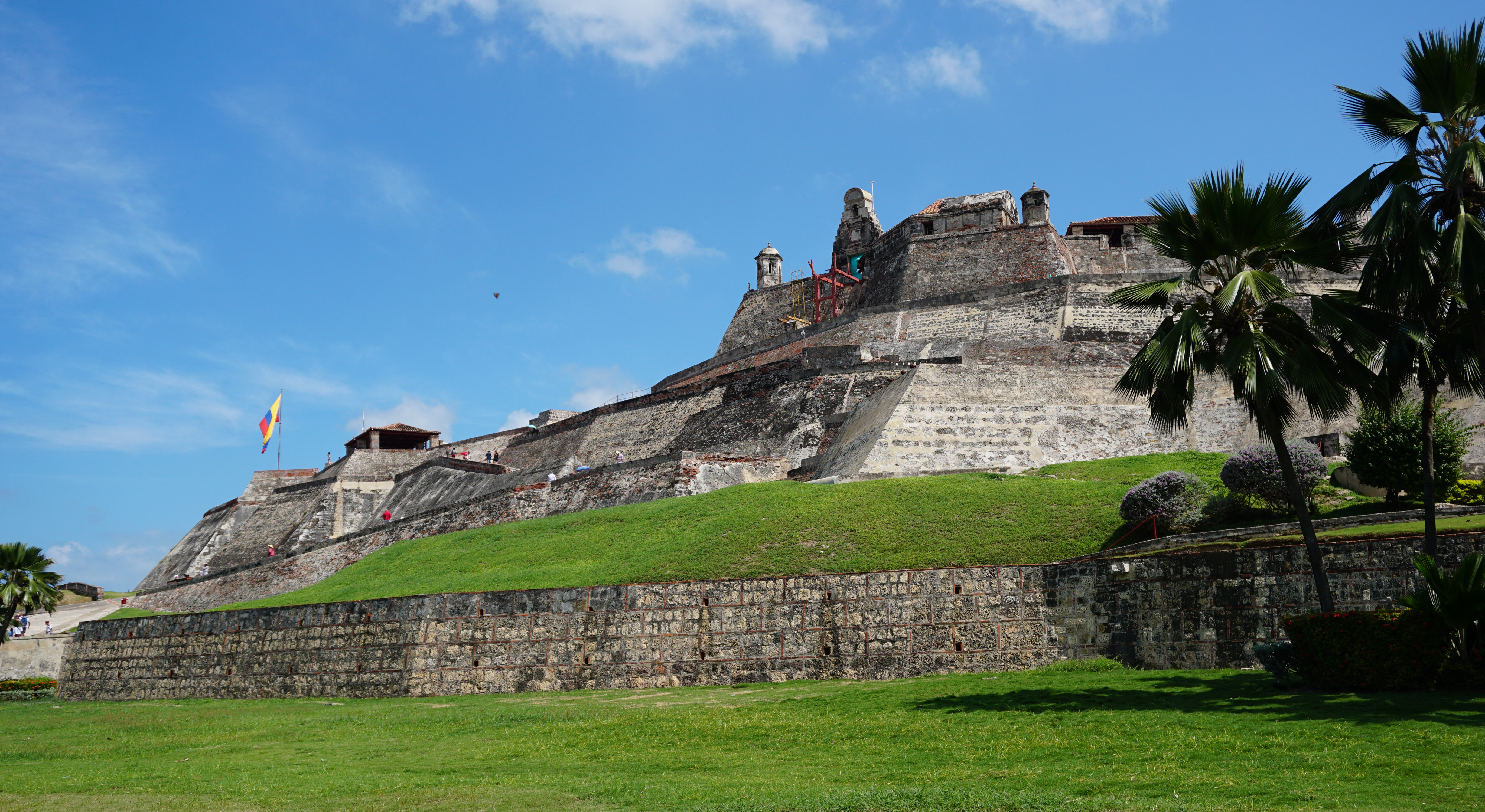|
Fort Mitchell, Florida
Fort Michell, located in today's Alachua County, was the capital of the short-lived Republic of East Florida during the Patriot War of 1814. Only one building was built, a 25-foot meterssquare, two-story blockhouse. It was located about one mile .6 kmfrom the city limits of modern Micanopy, Florida. Its precise location is not known. In January 1814, a group of soldier-settlers erected a two-story blockhouse and dubbed it Fort Mitchell, after the Governor of Georgia, David Mitchell. General Buckner F. Harris declared Fort Mitchell to be the capital of the Republic of East Florida. After building the fort, a petition was drafted to the U.S. Congress asking to annex the " District of Elotchaway lachuain the Republic of East Florida" (much larger than the current county) as a territory to the U.S. They also offered to send soldiers to fight the British as the War of 1812 The War of 1812 (18 June 1812 – 17 February 1815) was fought by the United States of America and its ... [...More Info...] [...Related Items...] OR: [Wikipedia] [Google] [Baidu] |
Alachua County, Florida
Alachua County ( ) is a county in the north central portion of the U.S. state of Florida. As of the 2020 census, the population was 278,468. The county seat is Gainesville, the home of the University of Florida since 1906, when the campus opened with 106 students. Alachua County is part of the Gainesville Metropolitan Statistical Area. The county is known for its diverse culture, local music, and artisans. Much of its economy revolves around the university, which had nearly 55,000 students in the fall of 2016. History Early history The first people known to have entered the area of Alachua County were Paleo-Indians, who left artifacts in the Santa Fe River basin before 8000 BCE. Artifacts from the Archaic period (8000 - 2000 BCE) have been found at several sites in Alachua County. Permanent settlements appeared in what is now Alachua County around 100 CE, as people of the wide-ranging Deptford culture developed the local Cades Pond culture. The Cades Pond culture ... [...More Info...] [...Related Items...] OR: [Wikipedia] [Google] [Baidu] |
Republic Of East Florida
The Republic of East Florida, also known as the Republic of Florida or the Territory of East Florida, was a putative republic declared by insurgents against the Spanish rule of East Florida, most of whom were from Georgia. John Houstoun McIntosh was chosen as "Director" of the self-named Patriots in March, 1812, to receive formal Spanish capitulation at Amelia Island. In July, while under the occupation of U.S. forces, the Patriots created a constitution of government that provided for an executive office, a legislative council, and a court system. Under its provisions, on July 27 McIntosh was named "Director of the Territory of East Florida". He was later succeeded in that office by Gen. Buckner Harris. Patriots wished neither independence nor statehood in the United States; they desired annexation by the U.S., connoted by the word "Territory" in their name of the country, and as expressly declared by the delegates at their constitutional convention. History General Mat ... [...More Info...] [...Related Items...] OR: [Wikipedia] [Google] [Baidu] |
Patriot War (Florida)
The Patriot War was an attempt in 1812 to foment a rebellion in Spanish East Florida with the intent of annexing the province to the United States. The invasion and occupation of parts of East Florida had elements of filibustering, but was also supported by units of the United States Army, Navy and Marines, and by militia from Georgia and Tennessee. The rebellion was instigated by General George Mathews, who had been commissioned by United States President James Madison to accept any offer from local authorities to deliver any part of the Floridas to the United States, and to prevent the reoccupation of the Floridas by Great Britain. The rebellion was supported by the Patriot Army, which consisted primarily of citizens of Georgia. The Patriot Army, with the aid of U.S. Navy gunboats, was able to occupy Fernandina and parts of northeast Florida, but never gathered enough strength to attack St. Augustine. United States Army troops and Marines were later stationed in Florida in supp ... [...More Info...] [...Related Items...] OR: [Wikipedia] [Google] [Baidu] |
Micanopy, Florida
Micanopy ( ) is a town in Alachua County, Florida, United States, located south of Gainesville. The population as of the 2010 census was 600. The oldest community in the interior of Florida that has been continually inhabited, it has a downtown that is designated as the Micanopy Historic District and listed on the National Register of Historic Places. It contains a number of antique stores, as well as several restaurants, a library, firehouse, and post office. The town's unofficial slogan is "The Town that Time Forgot." History In 1774 the American naturalist William Bartram recorded his impressions of a proto-Seminole village named ''Cuscowilla'' -- along with its chief, Cowkeeper or Ahaya -- located in the same vicinity as the modern town. By the time Spain ceded its Florida provinces to the U.S. in 1821, the newly constructed hamlet of Micanopy became the first distinct United States town in the Florida Territory. One of the founders was Moses Elias Levy, a wealthy Jew ... [...More Info...] [...Related Items...] OR: [Wikipedia] [Google] [Baidu] |
David Brydie Mitchell
David Brydie Mitchell (October 22, 1766 – April 22, 1837) was an American politician in Georgia who was elected in 1809 as governor of the state, serving two terms. He was elected again in 1815 for one term. Mitchell moved to Georgia at the age of 24. He had earlier been elected as mayor of Savannah and was appointed as state attorney general. He also served three terms in the Georgia General Assembly, two in the House of Representatives, and one in the Senate. Mitchell resigned from the governorship in 1817 to accept an appointment by President James Monroe as United States Indian Agent to the Creek Nation in their lands in present-day Georgia and Alabama. He followed the more than two-decade tenure of Benjamin Hawkins. In 1820 he was prosecuted for being involved in smuggling of American slaves from Spanish Florida. He was replaced in 1821 by President Monroe, who appointed John Crowell. Early life Mitchell was born in Muthill, Perthshire, Scotland, on October ... [...More Info...] [...Related Items...] OR: [Wikipedia] [Google] [Baidu] |
Buckner F
{{disambiguation, geo, given name ...
Buckner may refer to: People * Buckner H. Payne (1799-1889), American clergyman, publisher, and racist pamphleteer *Buckner Thruston (1763–1845), U.S. Senator and judge from Kentucky * Buckner (surname) Music * Buckner & Garcia was an American musical duo consisting of Jerry Buckner and Gary Garcia Places ;Japan * Buckner Bay, a former name for Nakagusuku Bay on Okinawa * Fort Buckner, a U.S. Army base on Okinawa ;United States * Buckner, Arkansas * Buckner, Kentucky * Buckner, Illinois * Buckner, Missouri * Buckner, Texas * Buckner Mountain in Washington See also *Bruckner (other) Anton Bruckner (1824–1896) was an Austrian composer. Bruckner may also refer to: * Bruckner (surname) * Anton Bruckner Private University for Music, Drama, and Dance, in Austria * Bruckner Expressway, in the Bronx, New York *Bruckner Glacier, G ... [...More Info...] [...Related Items...] OR: [Wikipedia] [Google] [Baidu] |
Seminole Wars
The Seminole Wars (also known as the Florida Wars) were three related military conflicts in Florida between the United States and the Seminole, citizens of a Native American nation which formed in the region during the early 1700s. Hostilities commenced about 1816 and continued through 1858, with two periods of uneasy truce between active conflict. The Seminole Wars were the longest and most expensive, in both human and financial cost to the United States, of the American Indian Wars. Overview First Seminole War The First Seminole War (1817-1818)-"Beginning in the 1730's, the Spaniards had given refuge to runaway slaves from the Carolinas, but as late as 1774 Negroes idnot appear to have been living among the Florida Indians." After that latter date more runaway slaves began arriving from American plantations, especially congregating around " Negro Fort on the Apalachicola River." Free or runaways, "the Negroes among the Seminoles constituted a threat to the institutio ... [...More Info...] [...Related Items...] OR: [Wikipedia] [Google] [Baidu] |
War Of 1812
The War of 1812 (18 June 1812 – 17 February 1815) was fought by the United States of America and its indigenous allies against the United Kingdom and its allies in British North America, with limited participation by Spain in Florida. It began when the United States declared war on 18 June 1812 and, although peace terms were agreed upon in the December 1814 Treaty of Ghent, did not officially end until the peace treaty was ratified by Congress on 17 February 1815. Tensions originated in long-standing differences over territorial expansion in North America and British support for Native American tribes who opposed US colonial settlement in the Northwest Territory. These escalated in 1807 after the Royal Navy began enforcing tighter restrictions on American trade with France and press-ganged men they claimed as British subjects, even those with American citizenship certificates. Opinion in the US was split on how to respond, and although majorities in both the House an ... [...More Info...] [...Related Items...] OR: [Wikipedia] [Google] [Baidu] |
Buildings And Structures In Alachua County, Florida
A building, or edifice, is an enclosed structure with a roof and walls standing more or less permanently in one place, such as a house or factory (although there's also portable buildings). Buildings come in a variety of sizes, shapes, and functions, and have been adapted throughout history for a wide number of factors, from building materials available, to weather conditions, land prices, ground conditions, specific uses, prestige, and aesthetic reasons. To better understand the term ''building'' compare the list of nonbuilding structures. Buildings serve several societal needs – primarily as shelter from weather, security, living space, privacy, to store belongings, and to comfortably live and work. A building as a shelter represents a physical division of the human habitat (a place of comfort and safety) and the ''outside'' (a place that at times may be harsh and harmful). Ever since the first cave paintings, buildings have also become objects or canvasses of much art ... [...More Info...] [...Related Items...] OR: [Wikipedia] [Google] [Baidu] |
Forts In Florida
A fortification is a military construction or building designed for the defense of territories in warfare, and is also used to establish rule in a region during peacetime. The term is derived from Latin ''fortis'' ("strong") and ''facere'' ("to make"). From very early history to modern times, defensive walls have often been necessary for cities to survive in an ever-changing world of invasion and conquest. Some settlements in the Indus Valley civilization were the first small cities to be fortified. In ancient Greece, large stone walls had been built in Mycenaean Greece, such as the ancient site of Mycenae (famous for the huge stone blocks of its 'cyclopean' walls). A Greek ''Towns of ancient Greece#Military settlements, phrourion'' was a fortified collection of buildings used as a military garrison, and is the equivalent of the ancient Roman, Roman castellum or English language, English fortress. These constructions mainly served the purpose of a watch tower, to guard certa ... [...More Info...] [...Related Items...] OR: [Wikipedia] [Google] [Baidu] |
Blockhouses
A blockhouse is a small fortification, usually consisting of one or more rooms with loopholes, allowing its defenders to fire in various directions. It is usually an isolated fort in the form of a single building, serving as a defensive strong point against any enemy that does not possess siege equipment or, in modern times, artillery, air force and cruise missiles. A fortification intended to resist these weapons is more likely to qualify as a fortress or a redoubt, or in modern times, be an underground bunker. However, a blockhouse may also refer to a room within a larger fortification, usually a battery or redoubt. Etymology The term ''blockhouse'' is of uncertain origin, perhaps related to Middle Dutch '' blokhus'' and 18th-century French '' blocus'' (blockade). In ancient Greece Blockhouses existed in ancient Greece, for example the one near Mycenae. Early blockhouses in England Early blockhouses were designed solely to protect a particular area by the use of arti ... [...More Info...] [...Related Items...] OR: [Wikipedia] [Google] [Baidu] |







